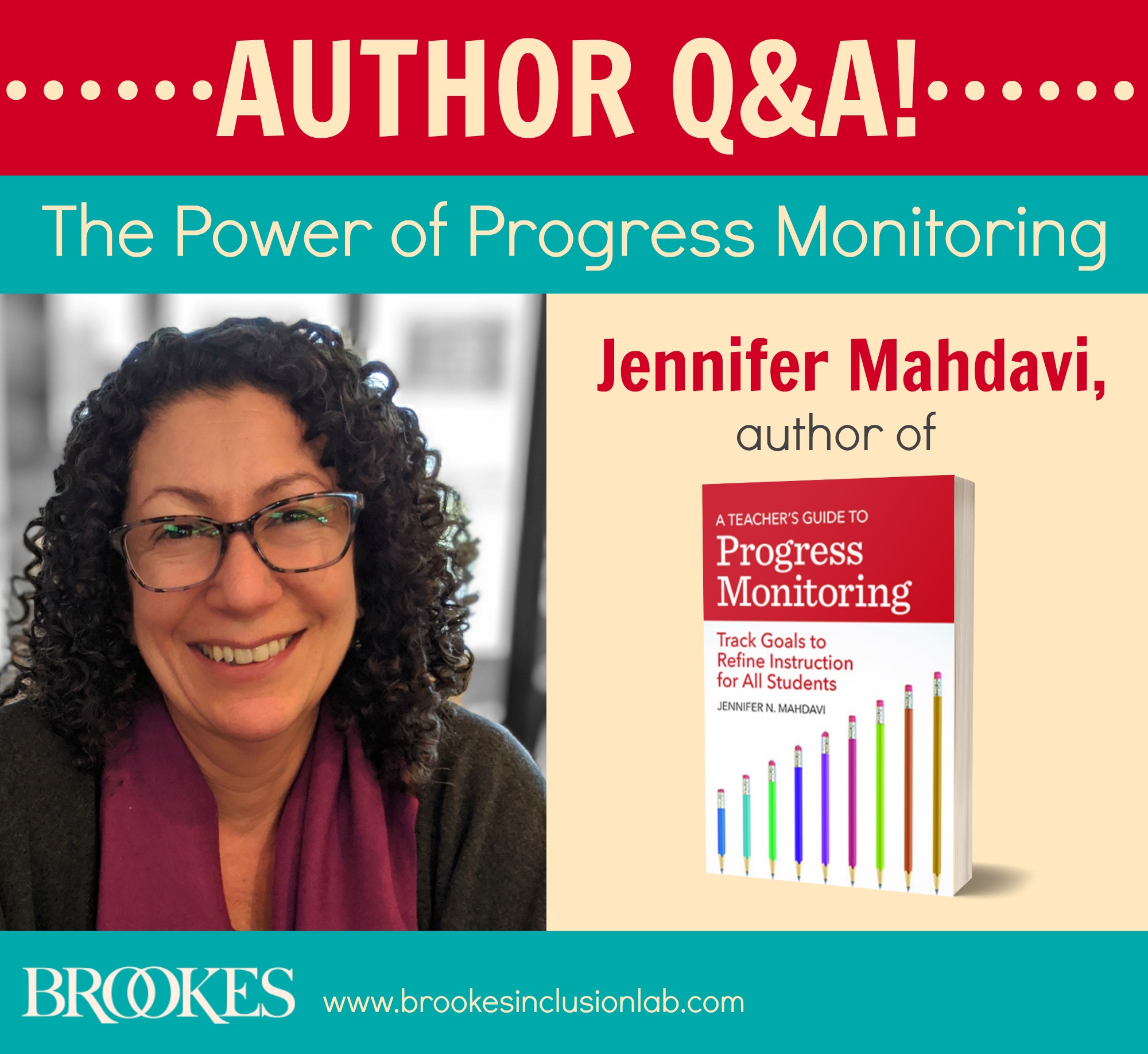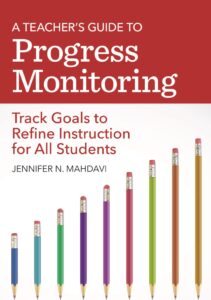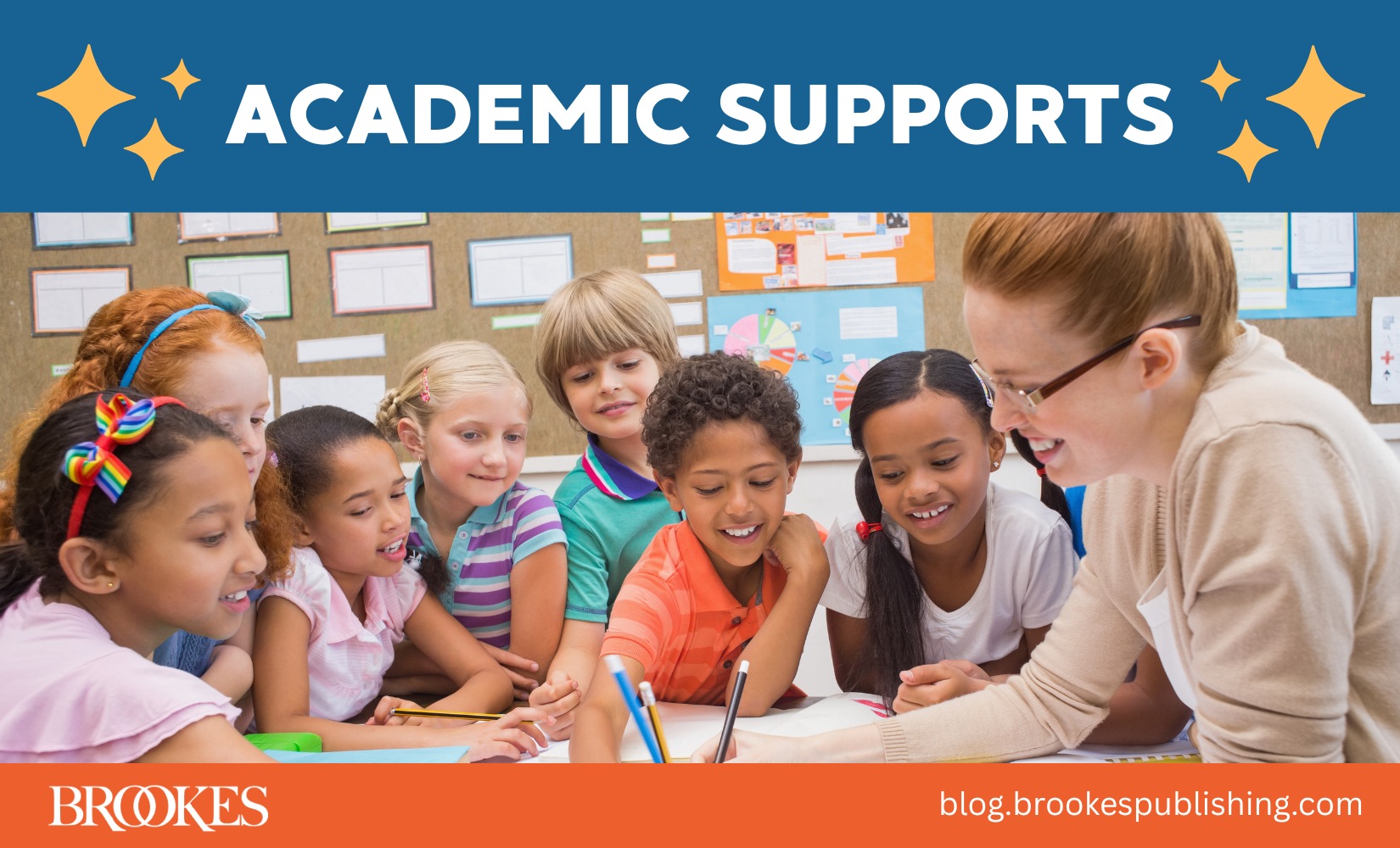“A Small Investment with Tremendous Dividends”: Jennifer Mahdavi on the Power of Progress Monitoring
November 10, 2020
 In a uniquely challenging year that has forced education into new locations and configurations, it’s more important than ever to collect data, make data-based instructional decisions, and monitor student progress toward goals. Brookes author Jennifer Mahdavi is with us today to talk about progress monitoring and why it remains a vital part of improving outcomes for all children. We asked Dr. Mahdavi some questions about her new book, A Teacher’s Guide to Progress Monitoring; her advice for busy teachers concerned about the time investment; and how teachers can approach progress monitoring in virtual learning environments.
In a uniquely challenging year that has forced education into new locations and configurations, it’s more important than ever to collect data, make data-based instructional decisions, and monitor student progress toward goals. Brookes author Jennifer Mahdavi is with us today to talk about progress monitoring and why it remains a vital part of improving outcomes for all children. We asked Dr. Mahdavi some questions about her new book, A Teacher’s Guide to Progress Monitoring; her advice for busy teachers concerned about the time investment; and how teachers can approach progress monitoring in virtual learning environments.
- We’re excited about your new book, A Teacher’s Guide to Progress Monitoring. Why, in your opinion, is this book urgently needed right now?
When I was an elementary school teacher, more than 25 years ago, I worked for a principal who urged us to use assessment to focus our instruction on the skills that students needed rather than to scatter our instruction and hope that something would work. That idea, which came with some rudimentary professional development, sparked my further exploration of aligning instruction with specific student needs. At the time, I did not have the tools to systematically monitor the progress of students and use those data to refine instruction.
The tools and knowledge that I did not have then are widely available now, they are evidence-based, and they are not terribly difficult to use. Children who are struggling to learn, whether academically, socially, behaviorally, or functionally, need and deserve to have their needs met by their teachers. Progress monitoring (PM) can empower the instructional strategies that teachers select, which will supercharge the growth that their students make. The small investment that teachers make in learning and using PM procedures will pay tremendous dividends in the growth and development of children with disabilities or those who struggle.
- What feature (or features) sets your book apart from other books on progress monitoring?
Most books about progress monitoring maintain a focus on academic learning. These books are relevant for struggling readers or children who have trouble in math, as well as students who have mild disabilities that affect their academic performance. My book expands the notion of progress monitoring to non-academic skills, particularly functional life skills that contribute to independence. For students with more severe disabilities, areas of focus may include self-feeding, choice-making, using public transit, or even independent toileting. We can use task analysis to create methods of monitoring independence in each step of the process of any functional skill. As such, my book is relevant to teachers of students of a wide variety of ages and ability levels.
Further, the methods described in the book are illustrated with 5 case studies, written by special educators, describing PM procedures that were designed, implemented, and evaluated with students with disabilities in classrooms. These real-life examples candidly reveal how teachers approached progress monitoring, the obstacles they encountered, and the successes they realized. The case studies represent the broad notion of PM that I was mentioning above, from an elementary school English learner with a learning disability increasing reading fluency, to a 12-year-old girl learning to make appropriate choices, to a high school junior developing his executive functioning to organize how he completed schoolwork.
- What are some of the practical applications of progress monitoring? What are the biggest classroom challenges it can help teachers solve?
Not every student needs to be the subject of a progress monitoring procedure. Those who are not learning at an expected pace are the ones on whom teachers need to focus. When a child’s oral reading fluency is not advancing, or their ability to solve long division problems is lagging, implementing PM for that individual is called for. It is the same for individuals with more significant disabilities; some will readily learn to perform functional activities such as making a sandwich or sorting items at a worksite. Those who do not will need to have the extra attention that comes with PM procedures. Progress monitoring is best implemented for individual students who present the most intractable learning needs.
For many teachers, working with a student over a period of time without seeing growth is a very frustrating experience. We work diligently to teach each student using evidence-based practices, yet some students do not respond to the interventions. PM helps us break through the obstacles to learning by showing us whether interventions are effective. Rather than teaching and teaching and hoping that students are learning, progress monitoring alerts us that the selected intervention is not of benefit to a student so we must choose another. This allows teachers to be nimbler in making changes to instruction in a timely fashion, which can accelerate progress.
- You include a chapter in your book on engaging students in monitoring their own progress. What are the benefits of that approach, for both teachers and students?
There is no greater benefit of education to students than that of independence. Teachers’ major priority must be to increase each student’s future ability to live, think, and work without external supports. We want to create independent readers, to turn students into adults who can think critically, and to help individuals with disabilities develop the skills they need to have agency over their own lives and choices.
Inviting students to participate in monitoring their own progress, setting goals to pursue, and discussing how to achieve new benchmarks, allows students to practice independence with the guidance of teachers. We can think of this as training wheels when we learn to ride a bike: a bit of assistance that prepares us to ride off on our own. Even students with cognitive delays have demonstrated the ability to make choices and evaluate their progress, sometimes in simple ways.
Progress monitoring can be something that teachers do with students rather than to them. We can and should create a partnership with students to increase their motivation to work toward goals. The benefit to students is increasing levels of independence. For teachers, the benefits are less clear. Certainly, students who function with less support make the teacher’s work easier, but the satisfaction of helping a person prepare for autonomy is the real joy.
- Many teachers may feel that the type of progress monitoring you propose would be incredibly helpful if they only had the time to do it. What would you say to busy teachers who are concerned about adding something else to their schedule? Can you share any tips on how stressed-out educators can make progress monitoring work?
Time is always the enemy of change. Implementing new initiatives is difficult and we never have enough time to figure it out. Even so, the power of progress monitoring in aligning interventions with student needs allows teachers to be more effective and more efficient. We do not need to waste time providing interventions that do not yield benefits to students; instead, we can fine-tune our instruction so that students learn more quickly. Investing the time to develop progress monitoring systems will yield successful student outcomes that are far greater than the efforts we made to get started.
For educators who are taking a deep breath and preparing to give progress monitoring a try, I say: start small! Pick one or two students with similar needs and implement PM with them as a pilot project. There is no need to sweep through your entire class list or caseload. Instead, practice with a small group and scale up when you feel comfortable with what you have created.
A second tip for getting started is to find a buddy who will engage in PM with you. Having a colleague who can help you when you get stuck—or bounce around ideas with you—will be most useful and supportive. Create a community of practice. You might also talk with the school psychologist at your site who should have expertise in progress monitoring.
If you are stressed out about whether your students are learning, progress monitoring can alleviate your anxiety. It will show you whether your instruction is reaching the students and empower you to change your approach as you need to. You will feel confident that all the efforts you are making are beneficial to your students. That, too, will alleviate stress. You have nothing to lose and everything to gain by trying PM out!
- What are some considerations for teachers wondering how to conduct effective progress monitoring in virtual learning environments?
Progress monitoring from a distance could be considered an advanced teaching maneuver! Still, it is possible if teachers have a productive working relationship with parents who are facilitating in-home learning. If parents are willing and able, teachers can teach them to take and report PM data. These data could then be used, as normal, to plan instruction, and to evaluate intervention results.
Enlisting students in collecting and analyzing PM data would also be in perfect alignment with the idea of self-determination and students’ involvement in their own educational experiences. In fact, working with students to set their own goals, take their own data, and direct their learning could be an excellent way to keep them motivated while they must learn at home, seeing their teachers only via a screen. To the extent that your students are cognitively able to participate in planning their own direction, I can’t think of a better way to conduct PM effectively while we must teach from a distance.
***
Thanks to Dr. Mahdavi for being here today and sharing her progress monitoring expertise. For more in-depth guidance on using PM to comply with federal mandates, refine your teaching, and help every learner succeed, check out her brand-new book:
 A Teacher’s Guide to Progress Monitoring
A Teacher’s Guide to Progress Monitoring
Track Goals to Refine Instruction for All Students
By Jennifer N. Mahdavi, Ph.D.
This is the practical, teacher-friendly guide you need to harness the power of progress monitoring (PM) and uncover what is and isn’t working in your classroom. You’ll start with a complete introduction to the fundamentals of progress monitoring, including why it’s a critical component of response to intervention (RTI) and multi-tiered systems of support (MTSS); how to use it in academic, behavioral, and functional settings; and how to support your teaching and assessment through task analysis. Then you’ll get real-world guidance on how to implement every key step in the PM process, from collecting data efficiently to making informed decisions about instruction. To bring PM principles to life, chapter-long case studies take you inside five classrooms and show you how real teachers used progress monitoring to support their students’ goals.
LEARN MORE NOW



Write a Comment
Your email address will not be published. Required fields are marked *
comments
shah says
Thanks for sharing this post.
Post a Comment